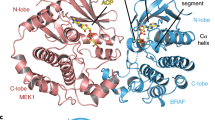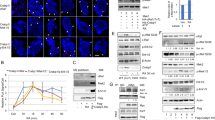Abstract
Retinoic Acid (RA) treatment induces disease remission of Acute Promyelocytic Leukaemia (APL) patients by triggering terminal differentiation of neoplastic cells. RA-sensitivity in APL is mediated by its oncogenic protein, which results from the recombination of the PML and the RA receptor α (RARα) genes (PML/RARα fusion protein). Ectopic expression of PML/RARα into haemopoietic cell lines results in increased response to RA-induced differentiation. By structure-function analysis of PML/RARα-mediated RA-differentiation, we demonstrated that fusion of PML and RARα sequences and integrity of the PML dimerization domain and of the RARα DNA binding region are required for the effect of PML/RARα on RA-differentiation. Indeed, direct fusion of the PML dimerization domain to the N- or C-terminal extremities of RARα retained full biological activity. All the biologically active PML/RARα mutants formed high molecular weight complexes in vivo. Functional analysis of mutations within the PML dimerization domain revealed that the capacity to form PML/RARα homodimers, but not PML/RARα-PML heterodimers, correlated with the RA-response. These results suggest that targeting of RARα sequences by the PML dimerization domain and formation of nuclear PML/RARα homodimeric complexes are crucial for the ability of PML/RARα to mediate RA-response.
This is a preview of subscription content, access via your institution
Access options
Subscribe to this journal
Receive 50 print issues and online access
$259.00 per year
only $5.18 per issue
Buy this article
- Purchase on Springer Link
- Instant access to full article PDF
Prices may be subject to local taxes which are calculated during checkout







Similar content being viewed by others
References
Alcalay M, Tomassoni L, Colombo E, Stoldt S, Grignani F, Fagioli M, Szekely L, Helin K and Pelicci PG. . 1998 Mol. Cell. Biol. 18: 1084–1093.
Brown, D, Kogan S, Lagasse E, Weissman I, Alcalay M, Pelicci PG, Atwater S and Bishop JM. . 1997 Proc. Natl. Acad. Sci. USA 94: 2551–2556.
Casini T and Pelicci PG. . 1998 Oncogene in press.
Chambon P. . 1996 FASEB J. 10: 940–954.
de Thé H, Lavau C, Marchio A, Chomienne C, Degos L and Dejean A. . 1991 Cell 66: 675–684.
Dyck JA, Maul GG, Miller WH, Chen JD, Kakizuka A and Evans RM. . 1994 Cell 76: 333–334.
Fagioli M, Alcalay M, Pandolfi PP, Venturini L, Mencarelli A, Simeone A, Acampora D, Grignani F and Pelicci PG. . 1992 Oncogene 7: 1083–1091.
Fagioli M, Alcalay M, Tomassoni L, Ferrucci PF, Mencarelli A, Riganelli D, Grignani FR, Pozzan T, Nicoletti I, Grignani F and Pelicci PG. . 1998 Oncogene 16: 2905–2913.
Fanelli M, Minucci S, Nervi C, Gambacorti-Passerini C and Pelicci PG. . 1998 Blood in press.
Flenghi L, Fagioli M, Tomassoni L, Pileri S, Gambacorta M, Pacini R, Grignani F, Casini T, Ferrucci PF, Martelli MF, Pelicci PG and Falini B. . 1995 Blood 85: 1871–1880.
Gaub MP, Lutz Y, Ruberte E, Petkovich M, Brand N and Chambon P. . 1989 Proc. Natl. Acad. Sci. USA 86: 3089–3093.
Grignani F, De Matteis S, Nervi C, Tomassoni L, Gelmetti V, Cioce M, Fanelli M, Ruthardt M, Ferrara FF, Zamir I, Seiser C, Grignani F, Lazar MA, Minucci S and Pelicci PG. . 1998 Nature 391: 815–818.
Grignani F, Fagioli M, Alcalay M, Longo L, Pandolfi PP, Donti E, Biondi A, Lo Coco F, Grignani F and Pelicci PG. . 1994 Blood 83: 10–25.
Grignani F, Ferrucci PF, Testa U, Talamo G, Fagioli M, Alcalay M, Mencarelli A, Grignani F, Peschle C, Nicoletti I and Pelicci PG. . 1993 Cell 74: 1–20.
Grignani F, Testa U, Rogaia D, Ferrucci PF, Samoggia P, Pinto A, Aldinucci D, Gelmetti V, Fagioli M, Alcalay M, Seeler J, Grignani F, Nicoletti I, Peschle C and Pelicci PG. . 1996 EMBO J. 15: 4949–4958.
Grisolano JL, Wesselschmidt RL, Pelicci PG and Ley TJ. . 1997 Blood 89: 376–387.
He LZ, Guidez F, Tribioli C, Peruzzi D, Ruthardt M, Zelent A and Pandolfi PP. . 1998 Nature Genet. 18: 126–135.
Kakizuka A, Miller Jr WH, Umesono K, Warrel Jr RP, Frankel SR, Murty VVVS, Dmitrovsky E and Evans RM. . 1991 Cell 66: 663–674.
Kastner P, Perez A, Lutz Y, Rochette-Egly C, Gaub MP, Durand B, Lanott M, Berger R and Chambon P. . 1992 EMBO J. 11: 629–642.
Koken MHM, Puvion-Dutilleul F, Guillemin MC, Viron A, Linares-Cruz G, Stuurman N, De Jong L, Szostecki C, Calvo F, Chomienne C, Degos L, Puvion E and De Thé H. . 1994 EMBO J. 13: 1073–1083.
Li-Zhen H, Tribioli C, Rivi C, Peruzzi D, Pelicci PG, Soares V, Cattoretti G and Pandolfi PP. . 1997 PNAS 94: 5302–5307.
Lin RJ, Nagy L, Inoue S, Shao W, Miller WH and Evans RM. . 1998 Nature 391: 811–814.
Liu JH, Mu ZM and Chang KS. . 1995 J. Exp. Med. 181: 1965–1973.
Mu Z-M, Chin K-V, Liu J-H, Lozano G and Chang K-S. . 1994 Mol. Cell. Biol. 14: 6858–6867.
Nervi C, Ferrara FF, Fanelli M, Rippo MR, Tomassini B, Ferrucci PF, Ruthardt M, Gelmetti V, Gambacorti-Passerini C, Diverio D, Grignani F, Pelicci PG and Testi R. . 1998 Blood in press.
Nervi C, Poindexter CE, Grignani F, Pandolfi PP, Lo Coco F, Avvisati G, Pelicci PG and Jetten AM. . 1992 Cancer Res. 52: 3687–3692.
Pandolfi PP, Grignani F, Alcalay M, Mencarelli A, Biondi A, Lo Coco F, Grignani F and Pelicci PG. . 1991 Oncogene 6: 1285–1292.
Perez A, Kastner P, Sethi S, Lutz Y, Reibel C and Chambon P. . 1993 EMBO J. 12: 3171–3182.
Raelson JV, Nervi C, Rosenauer A, Benedetti L, Monczak Y, Pearson M, Pelicci PG and Miller Jr WH. . 1996 Blood 88: 2826–2832.
Rogaia D, Grignani F, Grignani F, Nicoletti I and Pelicci PG. . 1995 Leukemia 9: 1467–1472.
Ruthardt M, Testa U, Nervi C, Grignani F, Puccetti E, Peschle C and Pelicci PG. . 1997 Mol. Cell. Biol. 17: 4859–4869.
Wang ZG, Delva L, Gaboli M, Rivi R, Giorgio M, Cordon-Cardo C, Grosveld F and Pandolfi PP. . 1998 Science 279: 1547–1551.
Warrell Jr RP, de Thé H, Wang ZY and Degos L. . 1993 New Engl. J. Med. 329: 177–189.
Weis K, Rambaud S, Lavau C, Jansen J, Carvahlo T, Carmo-Fonseca M, Lamond A and Dejean A. . 1994 Cell 76: 345–356.
Yoshida H, Kitamura K, Tanaka K, Omura S, Miyazaki T, Hachiya T, Ohno R and Naoe T. . 1996 Cancer Res. 56: 2945–2948.
Acknowledgements
This work was supported by grants from AIRC, MURST, CNR and EC (BiomedII program).
Author information
Authors and Affiliations
Rights and permissions
About this article
Cite this article
Grignani, F., Gelmetti, V., Fanelli, M. et al. Formation of PML/RARα high molecular weight nuclear complexes through the PML coiled-coil region is essential for the PML/RARα-mediated retinoic acid response. Oncogene 18, 6313–6321 (1999). https://doi.org/10.1038/sj.onc.1203029
Received:
Revised:
Accepted:
Published:
Issue Date:
DOI: https://doi.org/10.1038/sj.onc.1203029
Keywords
This article is cited by
-
Regulatory mechanism and functional analysis of S100A9 in acute promyelocytic leukemia cells
Frontiers of Medicine (2017)
-
Epigenetic changes by zebularine leading to enhanced differentiation of human promyelocytic leukemia NB4 and KG1 cells
Molecular and Cellular Biochemistry (2012)
-
The reduced and altered activities of PAX5 are linked to the protein–protein interaction motif (coiled-coil domain) of the PAX5–PML fusion protein in t(9;15)-associated acute lymphocytic leukemia
Oncogene (2011)
-
The self-association coiled-coil domain of PML is sufficient for the oncogenic conversion of the retinoic acid receptor (RAR) alpha
Leukemia (2011)
-
Oligomerization of Evi-1 regulated by the PR domain contributes to recruitment of corepressor CtBP
Oncogene (2005)



